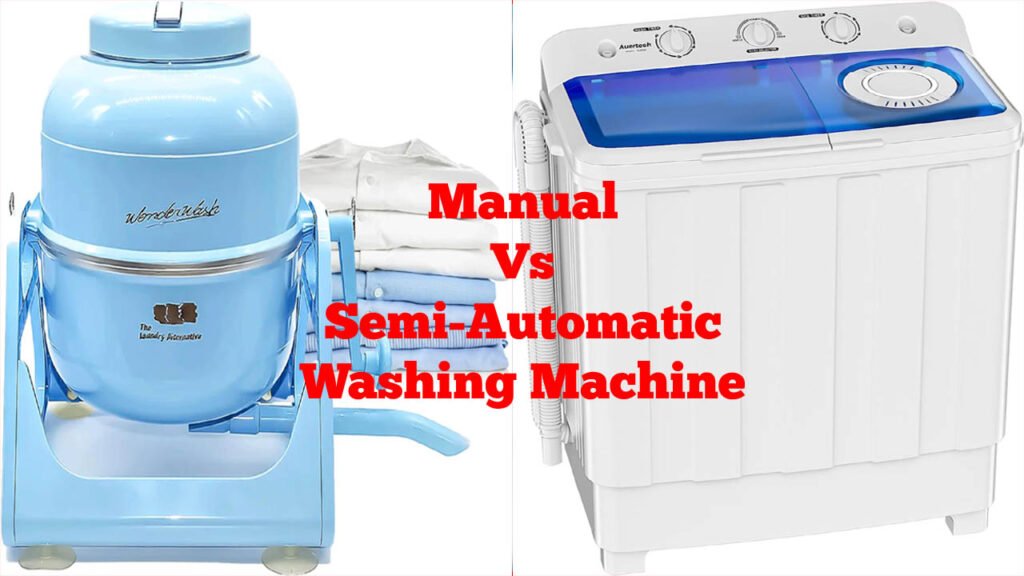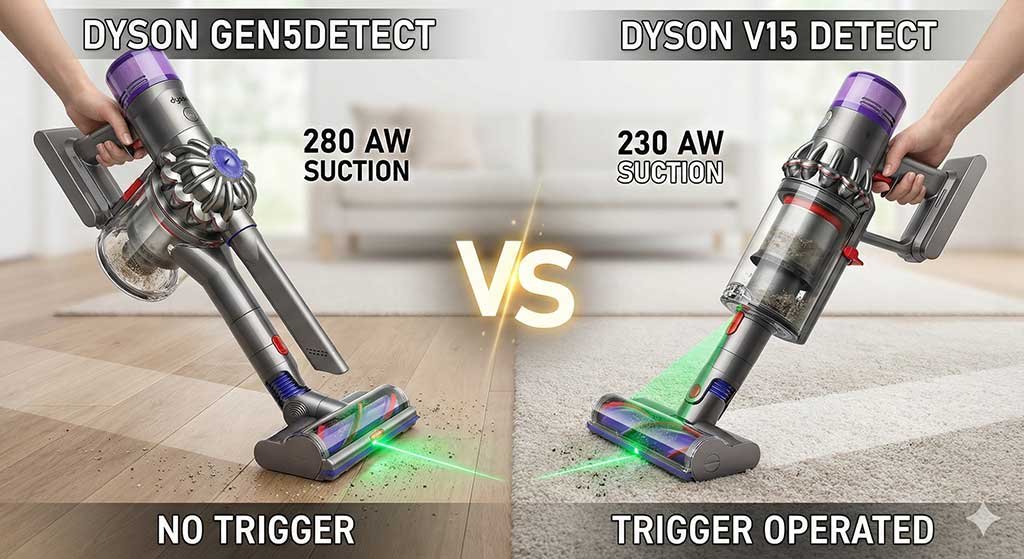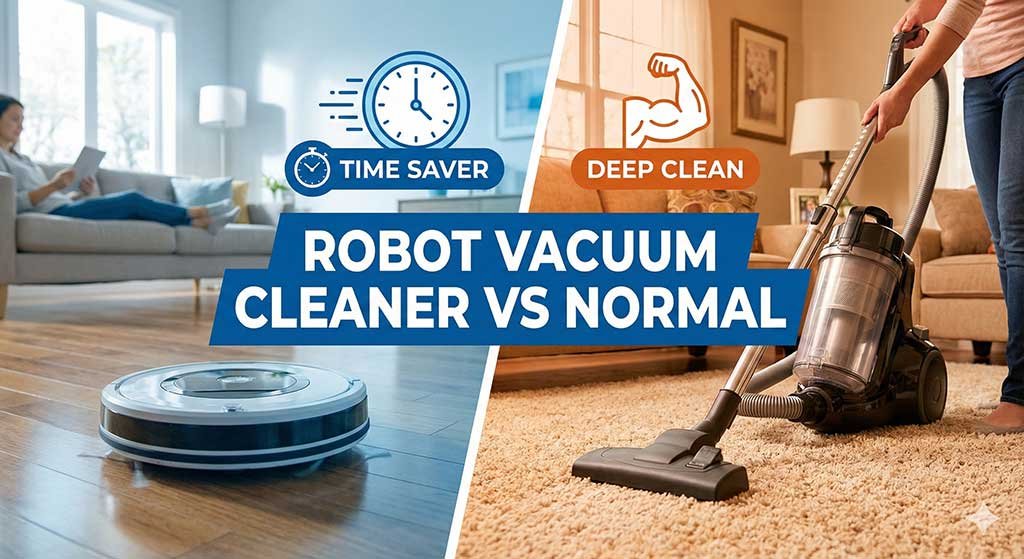Manual machines require full human operation, with users controlling every step. In contrast, semi-automatic machines combine manual and automated processes, easing some tasks. While manual demands hands-on involvement, semi-automatic strikes a balance, enhancing efficiency without fully relinquishing control.
Searching for the right washing machine means understanding the benefits and limitations of each type. Manual washing machines are budget-friendly and simple, consisting of two tubs for different stages of washing. Users must physically transfer the clothes from one tub to another.
In contrast, semi-automatic machines simplify the process with a single tub and an automated wash cycle, paused by timers to allow users to add water for rinsing or move clothes for spinning. These options eliminate some manual intervention but still require some user involvement compared to fully automatic counterparts.
Table of contents
Comparison: Manual Vs Semi-Automatic Washing Machine
Feature | Manual Washing Machine | Semi-Automatic Washing Machine |
|---|---|---|
Ease of Use | Requires more hands-on effort and attention. Users need to manually move clothes through the washing process. | Offers a blend of manual and automatic operation. Users have control over specific cycles, but some tasks are automated. |
Water Consumption | Generally uses more water as users manually fill and drain the water for each cycle. | Tends to be more water-efficient due to automatic water level sensors and controlled cycles. |
Energy Efficiency | Relies entirely on user judgment, so energy efficiency varies based on individual habits. | Generally more energy-efficient as it automates certain functions, optimizing energy use during cycles. |
Time and Effort | Requires more time and effort from users, especially for tasks like wringing clothes or moving them between wash and rinse cycles. | Reduces manual effort as the machine handles some tasks automatically, saving time and making laundry less labor-intensive. |
Cost | Typically more budget-friendly upfront, but operational costs can be higher due to increased water and energy consumption. | Initial cost may be higher, but operational costs tend to be lower due to better efficiency in water and energy usage. |
Space Requirement | Usually more compact and can be suitable for smaller spaces. | Generally larger and may require more space, particularly for the separate wash and spin tubs. |
Flexibility in Washing | Offers flexibility in controlling every aspect of the washing process, allowing users to adapt based on clothing types and preferences. | Provides a balance of user control and automation, offering flexibility while simplifying some tasks. |
Noise Level | Tends to be quieter during operation as it lacks automatic motors and pumps. | May produce more noise due to the inclusion of automatic components like pumps and motors. |
Maintenance | Typically simpler in design, which can make maintenance easier. | May require more maintenance due to additional components, but advancements have improved durability. |
Suitability for Users | Ideal for users who enjoy hands-on involvement in the laundry process and have time for manual tasks. | Suited for users seeking a balance between manual control and automated convenience, saving time and effort. |

Basic Variations
Basic variations between manual and semi-automatic washing machines is vital for consumers wanting to make an informed purchase. These two types of machines cater to different needs, efficiency levels, and user involvement. Let’s delve into what defines each type and how they differ in functionality and convenience.
Operational Mechanisms
Understanding how your washing machine works can be key to making the right purchase. Different operational mechanisms define the user experience and efficiency between manual and semi-automatic washers. Navigating through these variances will help you select the appliance that suits your laundry preferences and lifestyle needs.
Manual Intervention For Some Functions
Manual washing machines require a more hands-on approach during the wash cycle. Users often need to move the clothes from one tub to another for different cycles and closely monitor the machine. This implies:
- Filling the wash tub with water manually based on the load size.
- Adjusting settings like water level and duration for varying textiles and soil levels.
- Controlling the wash intensity by selecting the appropriate options.
- Transferring clothes to a separate tub for spinning and drying manually.
Automatic Washing And Spinning Cycles
In contrast to manual washers, semi-automatic machines streamline the laundry process significantly. Once loaded with clothes and detergent, these machines take over the majority of tasks:
- Automatic water intake takes the guesswork out of fill levels relative to load size.
- Pre-set wash programs auto-select the best cycle for the type of laundry being done.
- The machine will automatically rinse and move to a spin cycle without transferring the load.
- At the end of the cycle, the machine drains the water and signals that the laundry is ready for drying.
These semi-automatic functionalities are designed to offer convenience and save time, allowing users to multitask while their laundry is being handled efficiently.
Advantages And Limitations
Choosing between a manual and semi-automatic can be a game-changer in managing household chores. Understanding the advantages and limitations of these appliances helps streamline your laundry routine efficiently. Let’s delve into these aspects for a clearer choice.
Time-saving and user-friendly
Time-saving And User-friendly
When considering time efficiency and ease of use, the benefits become evident:
- Manual washing machines require you to move clothes from wash to rinse tubs, demanding your time and physical effort. Nonetheless, they offer control over the washing process.
- Semi-automatic machines, on the other hand, facilitate a more streamlined approach. Most models feature a built-in rinse cycle, meaning you only need to set up once and the machine will handle the transition from washing to rinsing.
The user-friendly nature of semi-automatic machines stands out for those with a busy schedule, allowing multitasking while laundry is being done.
Slightly higher cost and maintenance
Slightly Higher Cost And Maintenance
Although semi-automatic machines tout convenience, they come with their own set of considerations:
- Cost: Semi-automatic washers typically present a higher initial price than their manual counterparts. This is due to their advanced features and automation technology.
- Maintenance: With these advanced features, comes a potential increase in maintenance needs. Semi-automatic machines may have more complex parts that require professional servicing, which could lead to higher upkeep costs over time.
The balance between the initial investment and the long-term maintenance costs is crucial when making your decision.
Cleaning Quality
When considering the purchase of a washing machine, the cleaning quality is a paramount concern for most consumers. The debate between manual and semi-automatic often hinges on their operational differences and the effect these have on laundering. Understanding the nuances of each can help determine which type best suits your cleaning needs and lifestyle preferences.
Impacts Of Manual Versus Semi-automatic Operations
Manual and semi-automatic machines differ in several significant ways, each impacting the overall cleaning quality:
- Control: Manual washers offer greater control over the washing process. Users can determine the duration of the wash and apply any required manual effort to remove stubborn stains. This can sometimes yield a more thorough clean on heavily soiled items.
- Consistency: Semi-automatic machines provide a more consistent wash cycle due to preset programs, which can be particularly effective for everyday laundry, ensuring stable cleaning performance across various fabric types.
- Intervention: Semi-automatic operations require less user intervention once the wash cycle is started, thereby reducing the likelihood of human error in fabric care and cleaning efficacy.
Water Consumption Variance
In addition to operation style, water consumption plays a critical role in the quality of cleaning:
Type of Machine | Water Usage | Effect on Cleaning Quality |
|---|---|---|
Manual | Variable | User-regulated water levels can adapt to the needs of the laundry load, potentially enhancing stain removal through increased soak periods and targeted scrubbing. |
Semi-Automatic | Fixed or Adjustable | Water usage is generally predetermined, which can optimize water efficiency while sustaining effective cleanliness, particularly for regular washing requirements. |
Both the degree of manual intervention and water consumption of these washing machine types directly influence the overall cleaning quality. Manual washing machines allow for adaptable water usage, but they do demand a higher level of user involvement.
On the contrary, semi-automatic machines streamline the operation with predefined water levels, potentially saving on resources while still delivering a high-quality wash.
Energy Consumption
Understanding the energy consumption of a washing machine is crucial when deciding between a manual and a semi-automatic model. These appliances differ significantly not just in how they operate, but also in their power usage and efficiency.
Unpacking the energy costs associated with each type could lead to substantial savings on utility bills over the appliance’s lifespan. Let’s dive into the power requirements for different functionalities and the impact this has on long-term utility bills.
Power Requirements For Different Functionalities
Manual washing machines typically consume less power during their wash cycle compared to their semi-automatic counterparts. This is partly because they often require manual intervention to move clothes from one compartment to another, thus reducing the machine’s workload and consequently its energy use.
- Wash cycle: Mostly relies on user effort.
- Rinse cycle: Again, user effort prevails, with minimal power for agitation.
- Spin cycle: Manual machines may not have a spin cycle, leading to zero energy use.
In contrast, semi-automatic washing machines automate certain processes, increasing their energy consumption. They still allow control over certain aspects of the washing process, balancing user input with mechanical assistance. Below are their energy needs:
- Wash cycle: Uses more energy for agitation and timing.
- Rinse cycle: Semi-automatic functions require more energy but provide better convenience.
- Spin cycle: The automated spin cycle increases power consumption but offers faster drying times.
Impact On Long-term Utility Bills
The type of washing machine not only affects the immediate power draw during laundry but also tops into the cumulative energy costs. Manual machines could be more economical for users who are energy-conscious and don’t mind extra physical involvement.
On the flip side, semi-automatic machines may lead to higher electricity bills upfront but can save time and effort. Efficiency over time also plays a role; newer models may have energy-saving features that offset the initial higher consumption.
Type of Washing Machine | Annual Energy Consumption (kWh) | Cost (Based on Avg. Electricity Rate) |
|---|---|---|
Manual Washing Machine | < 100 kWh | $10 – $15 |
Semi-Automatic Washing Machine | 150 – 200 kWh | $20 – $30 |
Operational Effort
When deciding between a manual and a semi-automatic washing machine, understanding the level of operational effort required to run them is essential. Not only does this influence the user experience, but it also impacts the time and energy you’ll dedicate to your laundry routine.
Hands-on Approach With Manual Machines
With manual washing machines, users find themselves directly involved in practically every stage of the washing process. From filling the water to setting the wash cycle, and manually draining the used water, every action requires personal attention. This can be both a blessing and a chore, depending on your perspective and schedule.
- Filling the tub: You have to pour water into the machine until it reaches the required level.
- Soaking and scrubbing: Clothes often need to be soaked and occasionally scrubbed for better cleaning.
- Rinsing: After the wash cycle, you’ll need to add fresh water for rinsing, which may need several cycles.
- Wringing: Some manual machines include a wringer, but many times you’ll wring out clothes by hand.
This hands-on method provides a greater degree of control over how laundry is done but demands a significant time investment.
Hands-off Ability With Semi-automatic Machines
Semi-automatic washing machines strike a balance between manual effort and automation, giving users the best of both worlds. While they require some manual intervention, such as adding water and transferring clothes from the wash to the spin tub, they’re designed to take over most of the heavy lifting.
Feature | Benefit |
|---|---|
Automated Wash Cycle | Once you’ve selected the settings, the machine takes care of the cleaning process. |
Built-in Drain System | Draining dirty water becomes effortless with the push of a button. |
Separate Spin Tub | You can wash and spin-dry clothes simultaneously, saving time and effort. |
The key advantage is the reduced physical effort required compared to fully manual machines, providing a more relaxed laundry experience while still granting a measure of control over the process.
Programmability And Control
The heart of any washing machine is its ability to handle different types of clothing with the care they deserve. Among the myriad features that differentiate washing machines, programmability and control are pivotal in delivering a tailored washing experience. Whether you prefer a hands-on approach with a manual washer or relish in the convenience of a semi-automatic one, understanding the depth of customization available and how it affects your laundry routine is essential.
Customizability Of Wash Cycles And Settings
Manual washing machines offer a straightforward operation, with minimal settings that usually include wash time, water level, and wash type. Although fewer options might seem limiting, they offer a level of simplicity and direct control that some users find compelling. On the flip side, semi-automatic washing machines boast advanced programmability options, allowing users to tailor specific wash cycles and settings for different fabrics or soil levels:
- Multiple wash programs: Select from delicate, normal, or heavy-duty cycles.
- Temperature control: Some models enable you to set the water temperature, which can be crucial for certain fabrics.
- Soak timing: Pre-set soaking times to help remove challenging stains before the main wash cycle.
- Spin speed adjustment: Customize the spin speed to suit the load and reduce wear on clothes.
Influence On Laundry Management Convenience
The difference in programmability between manual and semi-automatic machines translates directly to convenience in managing your laundry. Manual washers demand more attention — you need to monitor the entire process, intervene to switch between cycles, and manually control wash times. This hands-on management can be seen as either a drawback or a nod to traditional washing techniques.
Conversely, semi-automatic machines streamline the laundry process. Once your preferences are set, the machine takes over, progressing through pre-programmed stages autonomously. This presents a significant advantage in multi-tasking and time management, allowing the user to:
- Start the machine and focus on other chores or relaxation.
- Benefit from consistent washing outcomes regardless of user input.
Semi-automatic machines undoubtedly cater to modern-day demands for efficiency and consistency. They shine in environments where time-saving and ease-of-use are the order of the day, while manual machines target those who prefer a more tactile approach to laundry or have specific constraints around electricity and water usage.
Wear And Tear
Discussing the ‘Wear and Tear’ aspect of washing machines is critical for understanding the longevity and performance of both manual and semi-automatic models. The way a machine operates can have significant implications on the integrity of its mechanical parts and ultimately the lifespan of the appliance itself. Making an informed decision between these two types can save on future maintenance costs and ensure a longer service life from your washing machine.
Effects On Mechanical Components Of Both Types
Manual and semi-automatic washing machines differ significantly in how they manage the task of cleaning clothes. The mechanical strain imposed on either type of washing machine is directly related to its operational mode.
- Manual machines often require more physical interaction, which can lead to increased wear on knobs and dials due to repeated manual adjustments.
- Semi-automatic machines, conversely, typically experience wear in their motors and transmission systems due to the automated movement of washing cycles.
Understanding the impact of these operational differences is crucial for anticipating maintenance needs and avoiding unexpected breakdowns.
Impact On Overall Lifespan
The anticipated lifespan of a washing machine is a paramount consideration. Manual washing machines are generally simpler in design, which may translate to fewer mechanical failures over time. This simplicity can potentially extend the machine’s lifespan, as there are fewer components subject to wear and tear.
Semi-automatic washing machines, with their advanced features and automated systems, may possess an increased number of mechanical parts – such as timers and sensors – which may be prone to wear out sooner. This can influence the necessity for more frequent repairs or replacements, potentially impacting their overall longevity.
Washing Machine Type | Common Wear Components | Lifespan Impact |
|---|---|---|
Manual | Knobs, Dials | Lower mechanical failure rate |
Semi-Automatic | Motors, Transmissions, Timers, Sensors | Higher mechanical failure rate |
It is evident that the choice between a manual and semi-automatic washing machine can have a substantial effect on the wear and tear experienced by the device. Users seeking to maximize the lifespan of their washing machine should weigh these considerations carefully.
Maintenance Efforts
Maintaining a washing machine is crucial to ensure its longevity and efficient performance. Between the two common types, manual and semi-automatic washing machines, maintenance efforts vary significantly. Understanding these differences can help consumers make an informed decision based on their willingness and ability to manage these tasks over time.
Upkeep Needs Of Manual Versus Semi-automatic Machines
The upkeep needs of manual and semi-automatic washing machines are distinct in several ways. Manual machines typically require more hands-on effort:
- Physical Operation: Users must move clothes from one tub to another, demanding more interaction.
- Cleaning: Since water does not drain automatically, users have to ensure proper water evacuation and tub cleaning after each use.
Semi-automatic machines, on the other hand, have features that reduce physical exertion:
- Wash and Spin Tubs: These machines often come with separate wash and spin tubs with an easy overflow system, partially automating the process.
- Drainage: Semi-automatic machines are equipped with hoses that facilitate easier drainage, minimizing manual cleaning requirements.
Long-term Costs And Care Requirements
In terms of long-term costs and care, the initial lower cost of a manual washing machine may be offset by higher maintenance in the long run:
Aspect | Manual | Semi-Automatic |
|---|---|---|
Durability | May require more frequent repairs due to hands-on use. | Better durability with less physical manipulation. |
Replacement Parts | Accessible parts but may need replacements sooner. | Longer lasting components, though possibly more expensive to replace. |
Energy Efficiency | Lower energy usage but manual effort is high. | Higher energy usage, but labor is significantly reduced. |
While semi-automatic machines may come with a higher upfront cost, the ease of maintenance and potentially lower frequency of repairs can make them more cost-effective over time. It’s important to balance these factors against personal time investment and the value of convenience.
Cost Analysis
Embarking on the journey of purchasing a washing machine places you at a crossroads: deciding between the traditional manual washing machines and their semi-automatic counterparts. One critical factor influencing this decision revolves around cost.
Cost analysis isn’t just about the initial price tag; it involves understanding the long-term implications associated with your choice. This comprehensive examination of both initial investment and long-term value shall guide you in choosing a washing machine that not only fits your budget but also delivers on performance and savings over time.
Initial Investment For Manual And Semi-automatic Options
The upfront cost of a washing machine is a pivotal factor for many households. Manual washing machines have been a staple for years due to their affordability, especially for those keeping a tight rein on expenditures.
In contrast, semi-automatic machines tend to ask for a higher initial outlay. This difference is due to the advanced technology and additional features semi-automatic models offer.
Type of Washing Machine | Average Initial Cost |
|---|---|
Manual | Lower |
Semi-Automatic | Higher |
Keep in mind that the price can fluctuate based on brand, capacity, and additional features even within each category.
Long-term Value Assessment
Beyond the initial purchase price, assessing the long-term value of your washing machine is equally essential. The running costs, maintenance, and longevity all contribute to this evaluation. Manual washing machines might seem economical initially, but they often require more energy and water per cycle, leading to higher utility bills over time.
- Energy Efficiency: Semi-automatic machines typically consume less water and energy per cycle, potentially lowering monthly bills.
- Maintenance Costs: With fewer sophisticated parts, manual machines can be cheaper to repair, but semi-automatic machines may offer greater durability with a longer lifespan.
- Longevity: Investing in a semi-automatic washing machine could mean a higher upfront cost but longer periods between replacements.
User Profiles
When choosing between a manual and semi-automatic washing machine, understanding user profiles becomes paramount. The distinct characteristics and lifestyle of a user play a pivotal role in determining which type of appliance will best suit their laundry routine.
Ideal Scenarios For Each Type Of User
Choosing a washing machine is not a one-size-fits-all decision. Whether manual or semi-automatic, each has scenarios where it outshines the other.
- Manual Washing Machine Users:
- Individuals with tight schedules who prefer to start their laundry and attend to other tasks.
- Users looking to maximize water efficiency for each load.
- Those who desire precise control over wash settings.
- Semi-Automatic Washing Machine Users:
- Users with enough space to accommodate larger machines and dedicated areas for drying.
- Households with varying fabric types necessitating different wash cycles.
- Those who prioritize the convenience of partially automated functions.
Aligning Machine Features With Individual Needs
Every user has unique requirements that determine the functionality they seek in a washing machine. Hence, it’s crucial to associate machine features with specific needs.
Feature | Manual | Semi-Automatic |
|---|---|---|
Control over cycles | Comprehensive | Limited |
Washing time | Customizable | Pre-set options |
Space required | Modest | Substantial |
Water usage | Adjustable per load | Typically higher consumption |
Energy consumption | Depends on usage | Generally efficient |
When aligning machine features with individual needs, consider elements such as the frequency of laundry, the types of fabrics regularly washed, and the user’s involvement in the washing process. For example, a high-efficiency manual washing machine could be more appealing to eco-conscious consumers who demand water conservation and customized wash settings.
Conversely, a semi-automatic machine is suitable for larger households that require robust washing capacities and partial automation of mundane tasks.
FAQ
Which One Is Better Automatic Or Manual Washing Machine?
On the other hand, semi-automatic machines strike a balance, automating some processes while allowing manual intervention. They’re ideal for individuals seeking efficiency without sacrificing control. If you prefer convenience and multitasking, a semi-automatic machine might be your go-to, as it handles certain tasks independently.
Consider factors like time, convenience, and your involvement in the washing process. While manual machines offer precision, semi-automatic ones provide a middle ground for those seeking a blend of control and ease in their laundry routine. Ultimately, the better choice hinges on your lifestyle and preferences.
What Are The Advantages Of Manual Washing Machine?
Manual washing machines are energy-efficient and cost-effective. They require no electricity, offering portability and convenience. Their simple design ensures easy maintenance and durability, which can be especially beneficial in areas with limited access to power.
What Are The Disadvantages Of Semi Washing Machine?
Semi-automatic washing machines require manual intervention for operation. They consume more water and time than fully automatic machines. Limited wash programs may not provide optimal cleaning for different fabric types, making them less versatile.
Final Words
Deciding between manual and semi-automatic washing machines is all about balance. Prioritize your time, budget, and effort for the best choice. Consider energy efficiency, cost, and convenience before purchasing. Embrace the ideal option that meshes with your daily laundry routine, ensuring clean clothes and peace of mind.
Choose wisely for an effortless laundry experience.



